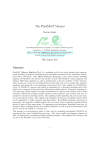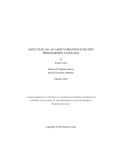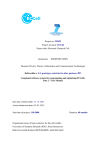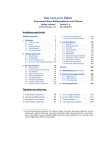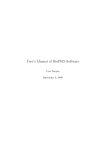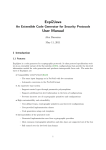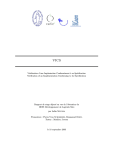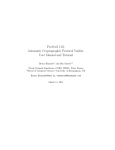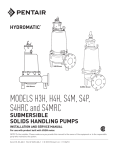Download s-COMMA User`s Manual
Transcript
s-COMMA User’s Manual Modeling Constraint Satisfaction Problems Edition 0.1, for s-COMMA Version 0.1 August 2007 Ricardo Soto, Laurent Granvilliers c 2004–2007 Laboratoire d’Informatique de Nantes Atlantique, France. Copyright Ricardo Soto Laboratoire d’Informatique de Nantes Atlantique Université de Nantes B.P. 92208, F-44322 Nantes cedex 3, France [email protected] Laurent Granvilliers Laboratoire d’Informatique de Nantes Atlantique Université de Nantes B.P. 92208, F-44322 Nantes cedex 3, France [email protected] The authors hereby grant you non-exclusive and non-transferable license to use, copy and modify this manual for non-commercial purposes. Acknowledgements We would like to thank Mathieu Albert, Thibault Le Port, Joris Meury and Éric Vépa for their support on the development of the ECLiPSe translator. We are also grateful to Thomas Douillard and Nicolas Berger for their work as beta testers. i Contents 1 Distribution License . . . . . . . . . . . . . . . . . . . . . . . . . . . . . . . . . . . . . . . . . . . . 1 1 2 Installation Software Requirements Installation . . . . . . Use of s-COMMA . . Bug Report . . . . . . . . . . 3 3 3 3 3 . . . . . . . . 5 5 5 6 6 7 8 9 11 . . . . . . . . . . . . . . . . . . 15 15 15 15 15 15 16 16 17 17 18 19 19 20 20 20 21 22 23 . . . . 25 25 25 25 27 . . . . . . . . . . . . . . . . . . . . . . . . . . . . . . . . . . . . . . . . . . . . 3 Overview Constraint Satisfaction Problems . . Solver Independence . . . . . . . . . 3.1 Constraint Modeling by Examples . Example: SEND+MORE=MONEY Example: N-Queens . . . . . . . . . Example: Perfect Squares . . . . . . Example: Perfect Squares . . . . . . Example: The Engine . . . . . . . . 4 Model Components 4.1 Constants . . . . . . Integer constants . . Real constants . . . Enumerations . . . . 4.2 Attributes . . . . . . Decision Variables . Constrained Objects 4.3 Constraint Zones . . Constraints . . . . . Loops . . . . . . . . Conditionals . . . . . Optimization . . . . Global Constraints . Global Constraints . 4.4 Object Composition 4.5 Inheritance . . . . . 4.6 Extensibility . . . . 4.7 Limitations . . . . . 5 The 5.1 5.2 5.3 5.4 . . . . . . . . . . . . . . . . . . . . . . . . . . . . . . . . . . . . Compiler Architecture . . . . . . . Translation process . . . From s-COMMA to Flat From Flat s-COMMA to . . . . . . . . . . . . . . . . . . . . . . . . . . . . . . . . . . . . . . . . . . . . . . . . . . . . . . . . . . . . . . . . . . . . . . . . . . . . . . . . . . . . . . . . . . . . . . . . . . . . . . . . . . . . . . . . . . . . . . . . . . . . . . . . . . . . . . . . . . . . . . . . . . . . . . . . . . . . . . . . . . . . . . . . . . . . . . . . . . . . . . . . . . . . . . . . . . . . . . . . . . . . . . . . . . . . . . . . . . . . . . . . . . . . . . . . . . . . . . . . . . . . . . . . . . . . . . . . . . . . . . . . . . . . . . . . . . . . . . . . . . . . . . . . . . . . . . . . . . . . s-COMMA . . . . . native solver models iii . . . . . . . . . . . . . . . . . . . . . . . . . . . . . . . . . . . . . . . . . . . . . . . . . . . . . . . . . . . . . . . . . . . . . . . . . . . . . . . . . . . . . . . . . . . . . . . . . . . . . . . . . . . . . . . . . . . . . . . . . . . . . . . . . . . . . . . . . . . . . . . . . . . . . . . . . . . . . . . . . . . . . . . . . . . . . . . . . . . . . . . . . . . . . . . . . . . . . . . . . . . . . . . . . . . . . . . . . . . . . . . . . . . . . . . . . . . . . . . . . . . . . . . . . . . . . . . . . . . . . . . . . . . . . . . . . . . . . . . . . . . . . . . . . . . . . . . . . . . . . . . . . . . . . . . . . . . . . . . . . . . . . . . . . . . . . . . . . . . . . . . . . . . . . . . . . . . . . . . . . . . . . . . . . . . . . . . . . . . . . . . . . . . . . . . . . . . . . . . . . . . . . . . . . . . . . . . . . . . . . . . . . . . . . . . . . . . . . . . . . . . . . . . . . . . . . . . . . . . . . . . . . . . . . . . . . . . . . . . . . . . . . . . . . . . . . . . . . . . . . . . . . . . . . . . . . . . . . . . . . . . . . . . . . . . . . . . . . . . . . . . . . . . . . . . . . . . . . . . . . . . . . . . . . . . . . . . . . . . . . . . . . . . . . . . . . . . . . . . . . . . . . . . . . . . . . . . . . . . . . . . . . . . . . . . . . . . . . . . . . . . . . . Index 33 References 35 Grammar of the Language 37 Grammar of Flat-s-COMMA 43 iv 1 Distribution s-COMMA 0.1 BSD License Copyright (c) 2004–2007, Laboratoire d’Informatique de Nantes Atlantique (LINA), France All rights reserved. Redistribution and use in source and binary forms, with or without modification, are permitted provided that the following conditions are met: • Redistributions of source code must retain the above copyright notice, this list of conditions and the following disclaimer. • Redistributions in binary form must reproduce the above copyright notice, this list of conditions and the following disclaimer in the documentation and/or other materials provided with the distribution. • Neither the name of the LINA nor the names of its contributors may be used to endorse or promote products derived from this software without specific prior written permission. THIS SOFTWARE IS PROVIDED BY THE COPYRIGHT HOLDERS AND CONTRIBUTORS ”AS IS” AND ANY EXPRESS OR IMPLIED WARRANTIES, INCLUDING, BUT NOT LIMITED TO, THE IMPLIED WARRANTIES OF MERCHANTABILITY AND FITNESS FOR A PARTICULAR PURPOSE ARE DISCLAIMED. IN NO EVENT SHALL THE COPYRIGHT OWNER OR CONTRIBUTORS BE LIABLE FOR ANY DIRECT, INDIRECT, INCIDENTAL, SPECIAL, EXEMPLARY, OR CONSEQUENTIAL DAMAGES (INCLUDING, BUT NOT LIMITED TO, PROCUREMENT OF SUBSTITUTE GOODS OR SERVICES; LOSS OF USE, DATA, OR PROFITS; OR BUSINESS INTERRUPTION) HOWEVER CAUSED AND ON ANY THEORY OF LIABILITY, WHETHER IN CONTRACT, STRICT LIABILITY, OR TORT (INCLUDING NEGLIGENCE OR OTHERWISE) ARISING IN ANY WAY OUT OF THE USE OF THIS SOFTWARE, EVEN IF ADVISED OF THE POSSIBILITY OF SUCH DAMAGE. 2 Installation Software and Hardware Requirements The compilation of s-COMMA requires Java 1.5 and Apache Ant. To date, s-COMMA is known to compile on ix86 computers under Linux and Windows. Installation The installation of s-COMMA is done in two steps: 1. Put the zip file in a directory where you have write permissions and unpack it: 2. Enter the subdirectory and install: % cd s-comma-0.1 % ant build Use of s-COMMA You should be able to call s-COMMA, using a target solver, by the following command: % ./comma -gecodej examples/Send.cma If the process succeeds, a solver-file will be generated in: src/comma/solverFiles/ Launch this file using the corresponding solver. Libraries called by solver-files are provided in the same folder. Solvers are not included in the distribution. Help about the s-COMMA usage and launch options can be obtained with: % ./comma -h Bug Report Please report bugs to Ricardo Soto by e-mail or by regular mail with subject “s-COMMA bug”. Suggestions for improvement are most welcome. LINA – Faculté des Sciences 2, rue de la Houssinière B.P. 92208 44322 Nantes Cedex 3 – France [email protected]. 3 3 Overview s-COMMA is a solver-independent language for modeling constraint satisfaction problems (CSP). In this section, we describe how problems are modeled using s-COMMA. Constraint Satisfaction Problems A CSP is a problem composed by data variables, usually called constants, decision variables and relations between the variables called constraints. The goal is to find values for the variables that satisfy the constraints. For instance the logical relation, x + y ≥ 0, is a constraint. The pair of values x = 0 and y = 0 is a feasible solution since 0 + 0 ≥ 0. This pair is declared consistent with respect to the constraint. The process of searching the solutions is done by solvers, which consists in eliminating inconsistent values. Initially, a domain is associated to each variable, i.e., the set of possible values a priori. Solvers implement domain reductions by means of consistency techniques and domain splitting in order to branch the solutions. Solver Independence Solver Independence means to separate the modeling from the solving concerns. This technique is implemented in a three layered architecture. A modeling layer, a mapping layer and a solving layer. Models are stated in the modeling layer, the mapping tool translates the models into an executable solver code and then the solving layer performs the solving process. Gecode/J Solver ECLiPSe Solver Model Mapping Tool RealPaver Solver GNU Prolog Solver Modeling Modeling Solving Figure 1: Solver Independence This architecture gives the possibility to plug-in new solvers and to process a same model with different solvers, which is useful to learn which solver is the best for the model. s-COMMA has been implemented using this technology. Currently, s-COMMA models can be translated to ECLiPSe [5], Gecode/J [2], RealPaver [4] and GNUProlog [3]. We expect to extend the list of supported solvers in further versions. 5 3.1 Constraint Modeling by Examples In this section we present some of the basic features of s-COMMA by means of three well-known Constraint-Based Problems. We begin with the SEND+MORE=MONEY puzzle. Example: SEND+MORE=MONEY The problem consists in finding distinct digits for the letters S, E, N, D, M, O, R, Y such that S and M are different from zero and the equation SEN D + M ORE = M ON EY is satisfied. In this problem, we may identify the following model information: • 8 variables: S, E, N, D, M, O, R, Y are the decision variables whose values must be searched. • 2 constraint: – The equation SEN D + M ORE = M ON EY . – all the variables must take different values. The s-COMMA model for the problem is as follows. We define a class called Send, then we define the 8 decision variables, each variable is represented by an integer type (int). Due to variables represent digits, its domain must be into [0, 9]. Variables s and m have a [1, 9] domain, whose values must be different from zero. import Global.ext; class Send{ int s in [1,9]; int e in [0,9]; int n in [0,9]; int d in [0,9]; int m in [1,9]; int o in [0,9]; int r in [0,9]; int y in [0,9]; constraint eq{ 1000*s + 100*e + 10*n + d + 1000*m + 100*o + 10*r + e = 10000*m + 1000*o + 100*n + 10*e + y; alldifferent(); } } We define a constraint zone called eq to post the constraints of the problem. First, we place 1000∗s+100∗e+10∗n+d+1000∗m+100∗o+10∗r +e = 10000∗m+1000∗o+100∗n+10∗e+y to represent the equation SEN D + M ORE = M ON EY ; and then we post the global constraint alldifferent(), which is imported from the extension file Global.ext (details about extension 6 files are presented in Section 4.6). This constraint forces that all values defined in the class must be different. Example: N-Queens The problem consists in placing N chess queens on an N x N chessboard such that none of them is able to capture any other using the standard chess queen’s moves. A solution requires that no two queens share the same row, column, or diagonal. In this problem, we may identify the following model information: • 1 constant: to determine the value of n. • n variables: one decision variable for each queen to represent their row positions on the chessboard. • 3 constraint: – To avoid that two queens are placed in the same row. – To avoid that two queens are placed in the first diagonal. – To avoid that two queens are placed in the second diagonal. The s-COMMA model for the problem is as follows. We define a class called Queens, then we define an array containing the n integer decision variables, each variable lies in [1, n]. The constant value of n is imported from the Queens.dat file. A constraint zone called noAttack contains the three constraints identified above. Two for loops ensures that the constraints are applied for the complete set of decision variables. ♦♦♦ int n:=6; import Queens.dat; class Queens{ int q[n] in [1,n]; constraint noAttack{ for(i:=1;i<=n;i++){ for(j:=i+1;j<=n;j++){ q[i] <> q[j]; q[i]+i <> q[j]+j; q[i]-i <> q[j]-j; } } } } 7 Example: Perfect Squares The goal of this problem is to place a given set of squares in a square area. Squares may have different sizes and they must be placed in the square area without overlapping each other. In this problem, we may identify the following model information: • 1 constant: to determine the size of the side of the area. • 1 constant: to determine the quantity of squares to place in the area. • square quantity constants: to determine the size of each square. • 2 x square quantity variables: to determine the x and the y position of the squares. • 2 constraint: – To ensure that the x coordinate of the square is placed inside the area. – To ensure that the y coordinate of the square is placed inside the area. • 1 constraint: to ensure that the squares do not overlap with each other. • 1 constraint: to ensure that the squares fit perfectly in the area. A s-COMMA model for the Perfect Squares Problem is as follows. Three constant values are imported from the data file , sideSize represents the side size of the square area where squares must be placed, squares is the quantity of squares (8) to place and size is an array containing the square sizes. Two integer arrays of decision variables are defined to represent respectively the x and y coordinates of the square area. So, x[2]=1 and y[2]=1 means that the second of the eight squares must be placed in row 1 and column 1, indeed in the upper left corner of the square area. Both arrays are constrained, the decision variables must have values into the domain [1,sideSize]. A constraint zone called inside is declared. In this zone a forall loop contains the constraints to ensure that each square is placed inside the area, one constraint about rows and the other about columns. The constraint noOverlap ensures that two squares do not overlap. The last constraint called fitArea ensures that the set of squares fit perfectly in the square area. ♦♦♦ int sideSize:=5; int squares:=8; int size:=[3,2,2,2,1,1,1,1]; 8 import PerfectSquares.dat; class PerfectSquares{ int x[squares] in [1,sideSize]; int y[squares] in [1,sideSize]; constraint inside{ forall(i in 1..squares){ x[i] <= sideSize - size[i] + 1; y[i] <= sideSize - size[i] + 1; } } constraint noOverlap{ forall(i in 1..squares){ for(j:=i+1;j<=squares;j++){ x[i] + size[i] <= x[j] or x[j] + size[j] <= x[i] or y[i] + size[i] <= y[j] or y[j] + size[j] <= y[i]; } } } constraint fitArea{ (sum(i in 1..squares) (size[i]*size[i])) = sideSize*sideSize; } } Example: An Object-Oriented version of the Perfect Squares A main feature of the s-COMMA language is the capability of combining constraints with an object-oriented framework. This kind of mix has been demonstrated to be useful for modeling CSP whose structure is inherently hierarchic (see the Engine Problem). Besides, this feature allow us to model in two different styles as we will show here giving a variant of the Perfect Square Problem. ♦♦♦ int sideSize :=5; int squares :=8; Square PerfectSquares.s := [{_,_,3},{_,_,2},{_,_,2},{_,_,2}, {_,_,1},{_,_,1},{_,_,1},{_,_,1}]; 9 import PerfectSquaresOO.dat; class PerfectSquares{ Square s[squares]; constraint forall(i s[i].x s[i].y } } inside{ in 1..squares){ <= sideSize - s[i].size + 1; <= sideSize - s[i].size + 1; constraint noOverlap{ forall(i in 1..squares){ for(j:=i+1;j<=squares;j++){ s[i].x + s[i].size <= s[j].x or s[j].x + s[j].size <= s[i].x or s[i].y + s[i].size <= s[j].y or s[j].y + s[j].size <= s[i].y; } } } constraint fitArea{ (sum(i in 1..squares) (s[i].size*s[i].size)) = sideSize*sideSize; } } class int int int } Square { x in [1,sideSize]; y in [1,sideSize]; size; As in the previous version, data values are imported from an external data file, sideSize represents the side size of the square area where squares must be placed, squares is the quantity of squares (8) to place; s is an instance of the array of Square objects declared at the beginning of the class PerfectSquares, a set of values is assigned to the third attribute (size) of each Square object of the array s. For instance, the value 3 is assigned to the attribute size of the first object of the array. The value 2 is assigned to the attribute size of the second, third and fourth object of the array. The value 1 is assigned to the attribute size of remaining objects of the array. We use standard modeling notation ( ) to omit assignments. Let us remark that we can perform direct value assignment for attributes of a class in the data file (as we did for the attribute size), this particularity gives us some benefits: 10 • Allow us to avoid the definition of constructors1 for each class. • We do not need to call a constructor each time an object is stated. If we need to perform an assignment we done it directly in the data file. • Omitting these statements, we obtain a cleaner definition of classes. At the PerfectSquares class, an array containing objects from the class Square is defined. This class (declared at the end of the model) is used to model the set of squares. Attributes x and y represent respectively the x and y coordinates. So, s[2].x=1 and s[2].y=1 means that the second of the eight squares must be placed in row 1 and column 1. Both variables (x,y) lie in [1,sideSize]. The last attribute called size represent the size of the square. Constraint zones inside, noOverlap and fitArea carry out the same goal explained in the previous example. Example: The Engine Consider the task of configuring a car engine using a compositional approach (see Figure 2). The engine at the first level is built from a crankcase, a cylinder system, a block and a cylinder head at the second level. The cylinder system is a subsystem made of a valve system, a piston system and an injection. Both valve and piston systems have their own composition rules. Engine Crankcase Valve Cylinder System Cylinder Head Block Valve System Injection Piston System Camshaft Connecting Rod Piston Crankshaft Figure 2: The Engine Problem The Engine class is at the top of the hierarchy. The attributes cCase, cSyst, block and cHead represent the subsystems of the engine. Those four constrained objects are instances of classes to be declared. The last attribute volume defines the volume of the engine. Then, a constraint between volume and the volume attribute of cCase is posted. The other classes and attributes are described in the same way, for instance the CrankCase class below. ♦♦♦ enum size := {xsmall,small,medium,large,xlarge}; enum flow := {direct,indirect}; 1 A constructor is a special function used to set up the class variables with values. It is used in most of object-oriented programing languages. 11 import Engine.dat, class Engine { CrankCase cCase; CylSystem cSyst; Block block; CylHead cHead; int volume in [890,4590]; constraint dim { volume > cCase.volume; } } class CrankCase { size type; int oilVesselVol in [145,300]; int bombePower in [255,400]; int volume in [3890,6540]; } The class CylSystem has a more complex declaration. The first attribute called quantity represents the quantity of cylinders; and the second represents the distance between cylinders. The cylinder system has three subsystems denoted by inj, vSyst and pSyst. Then, a constraint zone called determinePressure is declared to state a conditional constraint. This conditional constraint represents that 6-cylinder-engines have a distance between cylinders bigger that 6. In others kinds of engines the distance must be bigger than 3. In order to represent this constraint, an if-else statement is stated. If the condition is true, the first constraint is activated. Otherwise, the second constraint is activated. The cSyst object declared in the Engine class can be called a constrained object, due to it is an object subject to constraints on their attributes. class CylSystem { int quantity in [2,12]; int distBetCyl in [3,18]; Injection inj; ValveSystem vSyst; PistonSystem pSyst; constraint determinePressure { if (quantity = 6){ distBetCyl > 6; }else{ distBetCyl > 3; } } } The subsystem injection is composed of three attributes called gasFlow, admValve, and pressure. The decision variable gasFlow has a type called flow, which is an enumeration defined at the data file. If an enumeration is used as a type for a decision variable, the decision variable adopts as domain the set of values of the enumeration. Thus, gasFlow adopts as domain {direct,indirect}. 12 Likewise, the variable admValve adopts as domain {xsmall,small,medium,large,xlarge}. The injection class has also a compatibility constraint between its components. A compatibility constraint limit the combination of allowed values for the decision variables to a given set. For example, for variables type, admValve and pressure just four combination of values are allowed. The possible values are described inside the compatibility built-in constraint. class Injection { flow gasFlow; size admValve; int pressure in [80,130]; constraint compValues { compatibility(type,admValve,pressure) { ("direct", "small", 80); ("direct", "medium", 90); ("indirect", "medium", 100); ("indirect", "large", 130); } } } Remaining elements of the engine are not presented because they do not present additional features. Nevertheless, they can be view in the set of examples provided by the distribution. 13 4 Model Components In the previous section we have shown the basic features of s-COMMA models by means of some well-known examples. In this section we explain in more detail the components of models and constructs supported by the language. 4.1 Constants Constants, namely data variables, must be declared in a separate data file. Constants can be real, integer or enumeration types. Integer constants s-COMMA allows integer variables, integer arrays and integer matrix. The declaration of each one is as follows. ♦♦♦ int anIntegerConstant:=5; int anArrayOfIntegerConstants:=[1,2,3]; int aMatrixOfIntegerConstants:=[[1,2,3],[1,2,3],[1,2,3]]; Real constants The definition of real constants is the same as for integer constraints. ♦♦♦ real aRealConstant:=5.2; real anArrayOfRealConstants:=[1.1,2.2,3.3]; real aMatrixOfRealConstants:=[[1.1,2.2,3.3],[1.1,2.2,3.3],[1.1,2.2,3.3]]; Enumerations Enumerations can contain real, integer or string values. Enumerations are defined as follows. ♦♦♦ enum anEnumeration:={France, Italy, Germany}; 4.2 Attributes Attributes may represent decision variables or objects. Decision variables must be declared with an Integer, Real or Boolean type. Objects must be typed with their class name. 15 Decision Variables s-COMMA allows decision variables, arrays and matrix of decision variables. The size of the arrays and matrix can be defined by a constant, an integer value or an expression. The expression cannot contain decision variables, it must be composed by integers and/or constants. int real bool int real anIntegerDecisionVariable; aRealDecisionVariable; aBooleanDecisionVariable; anArrayOfIntegerDecisionVariables[5]; aMatrixOfRealDecisionVariables[5,anIntegerConstant+1]; Variables, arrays and matrix may be constrained to a determined domain. The domain must be defined with integer values for integer variables and real values for real variables. Constants and expressions can be used for defining domains, but expressions cannot contain decision variables. Attributes without domain adopt a default domain [-5000,5000] in the translation process2 int anIntegerDecisionVariable in [0,anIntegerConstant+1]; real aRealDecisionVariable in [0.5,5.5]; An enumeration can also be used as a type for a decision variable. The decision variable adopts as domain the set of values of the enumeration. ♦♦♦ enum size:= {small, medium, large}; size sizeOfTheComponent; Objects and Constrained Objects Objects are instances of s-COMMA classes, which can be stated as attributes in models. Constrained Objects are objects subject to constraints on their attributes. The constrained object firstEngine is shown below. Engine firstEngine; 2 If you need to modify the default domain please refer to : comma.control.managers.FeatManager.setDomainBounds() 16 4.3 Constraint Zones Constraint zones are used to group constraints encapsulating them inside a class. A constraint zone can contain constraints, loops, conditional statements, optimization statements, and global constraints. constraint inside{ forall(i in 1..squares){ x[i] <= sizeArea - size[i] + 1; y[i] <= sizeArea - size[i] + 1; } } Constraints Constraint are relations between variables. Table 1 shows the operators supported by the constraints. E is an expression and N represents any numeric type. Let us notice that some operators and types provided by s-COMMA are not supported by certain solvers, for details see Section 4.7. 2 <= 4 + anIntegerDecisionVariable; 2 <= 5.4 - aRealDecisionVariable; 17 Table 1: Binary and Unary Operators Operator <-> -> <and or xor < > <= >= ==,= !=,<> + * / - Operation Bi-Implication Implication Reverse Implication Conjunction Disjunction Exclusive or Less than Greater than Less than or equal Greater than or equal Equality Inequality Addition Subtraction Multiplication Division Numeric Negation Precedence 1200 1100 1100 1000 900 900 800 800 800 800 800 800 400 400 300 300 150 Relation (boolean × boolean) → boolean (boolean × boolean) → boolean (boolean × boolean) → boolean (boolean × boolean) → boolean (boolean × boolean) → boolean (boolean × boolean) → boolean (E × E) → boolean (E × E) → boolean (E × E) → boolean (E × E) → boolean (E × E) → boolean (E × E) → boolean (E × E) → N (E × E) → N (E × E) → N (E × E) → N N →N Loops s-COMMA provides the for loop and the forall loop. Loops can contain loops, conditionals and constraints. The for loop is declared as follows: The left side to declare the start value of the loop, the middle part to declare the stop condition, and the right side to declare the increment of the loop variable. Loop variables must not be declared, their validity begins when they are used to define the start value of a loop (the loop variable i in the left side i:=1 ) and their validity finish when their loop closes. for(i:=1;j<=5;i++){ q[i] > i; ... } The forall loop is declared in two parts. The left part to define the loop variable and a right part to define the set of values that the loop variable will traverse. The forall loop is always performed in an incremental sense. 18 forall(i in 1..5){ q[i] > i; ... } There exist another way to declare the right part. Instead of defining a set of values, we can use an enumeration or an array. The loop variable will cross from 1 until the size of the enumeration or array. forall(i in anEnumeration){ q[i] > i; ... } The sum loop performs an addition of a set of expressions. For example the expression a[1]*1 + a[2]*2 + a[3]*3 can be compressed in the statement shown below. sum(i in 1..5) (a[i]*i) Let us note that parentheses around a[i]*i are mandatory. Conditionals Conditionals are stated by means of the if and the if-else. Due to the conditional is represented by a logical formula, just one constraint is allowed inside the body of the conditional (we are improving this for further versions). if(a > b){ c > d; else { d < c; } Optimization Optimization statements are defined with a tag specifying the kind of optimization to perform. The [maximize] tag is used for maximizing and the [minimize] tag for minimizing expressions. 19 constraint reduce{ a + b > c; [minimize] a + b; } Global Constraints Two version of the alldifferent constraint are provided. The alldifferent(), forces that all values defined in the class must be different and the alldifferent(anIntegerArray), forces that all values inside an array must be different. The alldifferent constraint is the unique global constraint included in the s-COMMA version 0.1, it is included as a extension of the language on a file called Global.ext. Additional global constraints can be added using the extension mechanisms explained in Section 4.6. Compatibility Constraints As the explain in the Engine problem, a compatibility constraint limits the combination of allowed values for a set of decision variables to a set of given tuples. compatibility(a,b,c,d) { (3, 5, 8, 6); (1, 2, 5, 8); (9, 0, 3, 2); } A compatibility constraint can be viewed as a logic formula. For instance the compatibility constraint shown above can be represented by: (a=3 and b=5 and c=8 and d=6) or (a=1 and b=2 and c=5 and d=8) or (a=9 and b=0 and c=3 and d=2) 4.4 Object Composition The Object-Oriented framework provided by s-COMMA allows to represent models in an objectoriented style, as we shown by means of the Engine problem and the second version of the Perfect Squares problem. Let us remark that the main class of the model can be defined using the main reserved word. If there is no main class in the model, the first class defined in the model will be set as the main class. 20 main class Engine{ ... } Object composition can be used to represent hierarchic models. class Engine { CrankCase cCase; CylSystem cSyst; Block block; CylHead cHead; ... } Models can be stored in different files to be imported in a main file. import examples.Engine.cma import examples.ElectSystem.cma ... class Car { Engine ElectricSystem ExhaustSystem SuspSystem DriveTrain Chassis ... } eng; elSyst; exSyst; suSyst; drSyst; chass; Let us note that recursion is not allowed between classes. //not allowed class Engine{ Engine eng; } 4.5 Inheritance Inheritance is allowed in s-COMMA. Using the reserved word extends a subclass inherits every attribute and constraint defined in its superclass. Multiple inheritance is not allowed. 21 class TurboEngine extends Engine{ boost in [5,8]; ... } 4.6 Extensibility One of the interesting aspects of s-COMMA is the capability of extending the constraint language. In order to explain this feature let us go back to the Perfect Squares Problem. Consider that a Gecode/J programmer adds in the solver two new built-in functionalities: a constraint called noOverlap and a function called sumArea. The constraint noOverlap will ensure that two squares do not overlap and sumArea will sum the square areas of a square set. In order to use these functionalities we need to extend the constraint language. To this end, we define a new file (called extension file) where the rules of the translation are described. GecodeJ { Function { sumArea(s) -> "sumArea($s$)"; } Relation { noOverlap(x,y,size,squares) -> "noOverlap($x$, $y$, $size$, $squares$);"; } } ECLiPSe { Function { ... } ... This file is composed by one or more main blocks (see code above). A main block defines the solver where the new functionalities will be defined. Inside a main block two new blocks are defined: a Function block and a Relation block. In the Function block we define the new functions to add. In the example, the s-COMMA code is sumArea. This function name will be used to call the new function from s-COMMA. The input parameter of the new s-COMMA function is an array (s). Finally, the corresponding Gecode/J code is given to define the translation. The new function will be translated to sumArea(s);. Variables must be tagged with $ symbols. In the Relation block we define the new constraints to add. In the example, a new constraint called noOverlap is defined, it receives four parameters. The translation to Gecode/J is given. Once the extension file is completed, it can be called by means of an import statement. The resultant model using extensions is shown below. 22 import PerfectSquares.dat; import PerfectSquares.ext; class PerfectSquares { x[squares] in [1,sideSize]; y[squares] in [1,sideSize]; constraint placeSquares { forall(i in squares) { x[i] <= sideSize - size[i] + 1; y[i] <= sideSize - size[i] + 1; } noOverlap(x,y,size,squares); sumArea(size) = sideSize*sideSize; } } 4.7 Limitations Some features provided by s-COMMA are not supported by certain solvers. These limitations are explained below: • Gecode Translation – The solver has been designed to support finite domain integer constraints, in consequence real types are not supported. – Optimizations cannot be applied to a given set of variables, they are always performed for the whole set of variables defined in the model. • ECLiPSe Translation – Optimizations are not supported for real types. • GNU Prolog Translation – Optimizations are not supported for real types. – Matrix are not implemented yet. • RealPaver Translation – RealPaver is an interval software for modeling and solving nonlinear systems. Due to the continuous nature of intervals of real numbers, it is in general not possible to check the equality of values, and it is replaced with the membership operation. As a consequence, just the symbols (<=), (=>), (=) are allowed. 23 5 The Compiler In this section we explain the implementation of the s-COMMA compiler. We detail the architecture and the translation process from s-COMMA to solver models. 5.1 Architecture The s-COMMA system is supported by a three layered architecture: Modeling, Mapping and Solving (see Fig. 3). On the first layer, models are stated by the user, extension and data files can be given optionally. Models are syntactically and semantically checked by two ANTLR [1] tree-walkers. If the checking process succeeds, an intermediate model called Flat s-COMMA is generated. Finally, the Flat s-COMMA file is taken by the selected translator which generates the executable solver file. Gecode/J Translator Extension Compiler Extension File (Optional) Base Compiler Gecode/J Solver ECLiPSe Solver ECLiPSe Translator Flat s-COMMA Compiler Model Data Compiler Data File (Optional) Modeling RealPaver Translator RealPaver Solver GNU Prolog Translator GNU Prolog Solver Mapping Solving Figure 3: The s-COMMA compiling system. 5.2 Translation process Currently s-COMMA can be translated to four solvers. In order to simplify the translation process from s-COMMA to native solver models we use an intermediate model called Flat sCOMMA. 5.3 From s-COMMA to Flat s-COMMA The set of performed transformation from s-COMMA to Flat s-COMMA are described below. Flattening Composition The hierarchy generated by composition is flattened. This process is done by expanding each object declared in the main class adding its attributes and constraints in the Flat s-COMMA 25 file. The name of each attribute has a prefix corresponding to the concatenation of the names of objects of origin in order to avoid name redundancy. The expansion of the object cCase defined in the class Engine of the Engine Problem is shown below ♦♦♦ size int int int int cCase_base; cCase_oilVesselVol; cCase_bombePower; cCase_volume; cSyst_quantity in [2,12]; int cSyst_distBetCyl in [3, 18]; flow cSyst_inj_gasFlow; ... volume > cCase_volume; Loop Unrolling Loops are not widely supported by solvers, hence we generate an unrolled version of loops (for and forall). ♦♦♦ //s-COMMA forall(i in 1..3){ a[i] < a[i+1]; } //flat a[1] < a[2] < a[3] < s-COMMA a[2]; a[3]; a[4]; Conditional removal Conditional statements are transformed to logical formulas. For instance, if a then b else c is replaced to (a ⇒ b) ∩ (a ∪ c). ♦♦♦ //s-COMMA if(a=b) c>=d; else c<d; //flat s-COMMA (a=b) -> (c>=d) and (a=b) or (c<d); Compatibility removal Compatibility constraints are also translated to a logical formula. We create a conjunctive boolean expression for each n-tuple of allowed values. Then, each constraint of the n-tuple is stated in a disjunctive constraint. The transformed compatibility constraint of the Engine problem is shown below. ♦♦♦ ((type=1) and (admValve=1) and (pressure=80)) or ((type=1) and (admValve=2) and (pressure=90)) or ... Data substitution Data variables are replaced by its value defined in the data file. 26 Enumeration substitution In general solvers do not support non-numeric types. So, enum types are replaced by integer values, for example admValve in {small,medium,large} is replaced by admValve in [1,3]; original values are stored to give the results. Array decomposition Array containing objects are decomposed into single objects which are then expanded by the flattening composition described above. For instance, in the perfect squares problem, the array of objects called s is decomposed as follows: ♦♦♦ int s_1_x in [1,5]; int s_1_y in [1,5]; int s_2_x in [1,5]; int s_2_y in [1,5]; int s_3_x in [1,5]; ... The name of each variable is composed by the name of the array s, the position of the object in the array, and the name of the attribute of the object. Only, variables x and y are considered decision variables, the attribute size is considered constant due to has an instantiation (in the data file at line 3) for the whole set of objects contained in the array. The value 5 in the variables’ domain comes from the data substitution of the data variable sideSize. Logic formulas transformation Some logic operators are not supported by solvers. For example logical equivalence (a ⇔ b) and reverse implication (a ⇐ b). We transform logical equivalence expressing it in terms of logical implication ((a ⇒ b) ∩ (b ⇒ a)). Reverse implication is simply inversed (b ⇒ a). 5.4 From Flat s-COMMA to native solver models After the generation of the intermediate model, the Flat s-COMMA code is taken by the selected translator which generates the executable solver file. Single Data translation The data substitution process performed in the intermediate model generation replaces all the data variables with its corresponding value, so data is no longer needed in solver files. But specific extension could need it, so we give a data translation for solver files. 27 ♦♦♦ //flat s-COMMA aConstant:=5; //ECLiPSe ACONSTANT=5, //Gecode/J aConstant n=5; //GNUPROLOG ACONSTANT=5, //RealPaver aConstant=5, Data Array translation ♦♦♦ //flat s-COMMA anArrayOfConstants:=[1,2,3]; //Gecode/J int anArrayOfConstants[]={1,2,3}, //GNUPROLOG ANARRAYOFCONSTANTS=[](1,2,3), //RealPaver anArrayOfConstants=[1,2,3], //ECLiPSe ANARRAYOFCONSTANTS=[](1,2,3), Additional information can be regarded in the sources of the distribution: • comma.translators.gecodej.GecodeJDataVarsCodeGenerator.java • comma.translators.eclipse.EclipseDataVarsCodeGenerator.java • comma.translators.gnuprolog.GNUPrologDataVarsCodeGenerator.java • comma.translators.realpaver.RealPaverDataVarsCodeGenerator.java Single Variable translation Variables are mapped to their equivalent ones in solver languages. For instance in Gecode/J the object IntVar is used to define a decision variable, this represents the Java Space of Gecode/J, "aVariable" the name of the variable, and finally its domain ([2,5]) is defined. Then, the variable is added to a specific array for the labeling process (labeling-array). In ECLiPSe the variable is defined including its domain using the (::) notation. As in Gecode/J the variable is added to the labeling-array. The variable declaration for GNUProlog is performed by means of the fd domain predicate. Then, the variable is added to the labeling-array. The RealPaver case no needs explanation. ♦♦♦ //flat s-COMMA int aVariable in [2,5]; //Gecode/J IntVar aVariable = new IntVar(this,"aVariable",2,5); vars.add(aVariable); 28 ♦♦♦ //ECLiPSe AVARIABLE::[2..5], append([],VARS_AVARIABLE_,L_), //GNUProlog fd_domain(AVARIABLE,2,5), append([],VARS_AVARIABLE_,L_), //RealPaver aVariable in [2,5], Variable Array translation Arrays have a more complicated translation. For instance in Gecode/J the object VarArray is used to define an array of decision variables, a for loop is used to fill the VarArray with the five IntVar objects which represent the decision variables, finally the new array is added to the labeling-array. In ECLiPSe the predicate dim is used to define an array, then its domain is given, the two last code lines are used to insert the new array in the labeling-array. The variable declaration for GNUProlog is similar, the length predicate is used to define a list, fd domain is used to give the domain of its values, and the last code line is given to insert the new array in the labeling-array. The RealPaver case is similar to s-COMMA. ♦♦♦ //flat s-COMMA int anArrayOfVariables[5] in [3,8]; //Gecode/J VarArray<IntVar> anArrayOfVariables = new VarArray<IntVar>(); for(int i=1;i<=5;i++) { anArrayOfVariables.add(new IntVar(this,"anArrayOfVariables" + i,3,8)); } vars.addAll(anArrayOfVariables); //ECLiPSe dim(ANARRAYOFVARIABLES,[5]), ANARRAYOFVARIABLES::[3..8], ANARRAYOFVARIABLES=[_|VARS_ANARRAYOFVARIABLES_] append([],VARS_ANARRAYOFVARIABLES_,L_), //GNUProlog length(ANARRAYOFVARIABLES,5) fd_domain(ANARRAYOFVARIABLES,3,8), append([],ANARRAYOFVARIABLES,L_X_), //RealPaver aVariable[1..5] in [3,8], Additional information can be regarded in the sources of the distribution: 29 • comma.translators.gecodej.GecodeJDecVarsCodeGenerator.java • comma.translators.eclipse.EclipseDecVarsCodeGenerator.java • comma.translators.gnuprolog.GNUPrologDecVarsCodeGenerator.java • comma.translators.realpaver.RealPaverDecVarsCodeGenerator.java Constraint translation Constraints are translated in a very different way depending on the nature of the solvers’ language. For instance in Gecode/J, methods are used to define constraints, the post method is used to post a constraint, the p method represents the addition operator. The BExpr object is given to post boolean expressions, the Expr object is used to post math expressions, and IRT LQ represents the <= relation. ECLiPSe and GNU Prolog cases are similar to s-COMMA , in GNU the predicate nth is used to get a variable of the array. As we explain previously, due to the nature of the RealPaver solver it does not support the or operator. ♦♦♦ //flat s-COMMA x[1] + 3 <= x[2] or x[2] + 2 <= x[1] or y[1] + 3 <= y[2] or y[2] + 2 <= y[1]; //Gecode/J post(this,new BExpr(new BExpr(new BExpr( new Expr().p(new Expr().p(get(x,1))). p(new Expr().p(3)),IRT_LQ, new Expr().p(get(x,2))).or(new BExpr( new Expr(). p(new Expr().p(get(x,2))).p(new Expr().p(2)),IRT_LQ, new Expr().p(get(x,1))))). or(new BExpr( new Expr().p(new Expr().p(get(y,1))).p(new Expr().p(3)),IRT_LQ, new Expr().p(get(y,2))))).or(new BExpr( new Expr().p(new Expr().p(get(y,2))). p(new Expr().p(2)),IRT_LQ, new Expr().p(get(y,1))))); //ECLiPSe X[1]+3 $=< X[2] or X[2]+2 $=< X[1] or Y[1]+3 $=< Y[2] or Y[2]+2 $=< Y[1], //GNUPROLOG nth(1,X,X_1),nth(2,X,X_2),nth(3,X,X_3)... X_1+3 #=< X_2 #\/ X_2+2 #=< X_1 #\/ Y_1+3 #=< Y_2 #\/ Y_2+2 #=< Y_1, //RealPaver x[1] + 3 <= x[2]...// or not supported Additional information can be regarded in the sources of the distribution: • comma.translators.gecodej.GecodeJConstraintCodeGenerator.java • comma.translators.eclipse.EclipseConstraintCodeGenerator.java 30 • comma.translators.gnuprolog.GNUPrologConstraintCodeGenerator.java • comma.translators.realpaver.RealPaverConstraintCodeGenerator.java Formatters The name of the decision variables as well as the name of data variables need in general to be formatted for the specific syntax of the solver. This task is performed respectively by the following source codes: • comma.translators.gecodej.GecodeJFormatter.java • comma.translators.eclipse.EclipseFormatter.java • comma.translators.gnuprolog.GNUPrologFormatter.java • comma.translators.realpaver.RealPaverFormatter.java Headers Executable solver files need often specific headers to call libraries, procedures and/or to show the results in an adequate way. These tasks are performed respectively by the following source codes: • comma.translators.gecodej.GecodeJTranslator.java • comma.translators.eclipse.EclipseTranslator.java • comma.translators.gnuprolog.GNUPrologTranslator.java • comma.translators.realpaver.RealPaverTranslator.java 31 Index alldifferent, 20 architecture, 25 attributes, 15 compatibility, 20 compiler, 25 component, 20 composition, 20 conditional, 19 consistency technique, 5 consistent, 5 consistent value, 5 constant, 5, 15 array, 15 enumeration, 15 integer, 15 matrix, 15 real, 15 constrained object, 11, 16 constraint, 5, 17 Constraint Programming, 5 Constraint Satisfaction Problem, 5 constraint zone, 17 CSP, 5 minimize, 19 object, 16, 20 operator binary, 17 unary, 17 optimization, 19 search, 5 solver, 5 Solver Independence, 5 sum, 18 variable array, 15, 25 boolean, 15, 25 integer, 15, 25 matrix, 15, 25 real, 15, 25 data variable, 15 decision variable, 15 decision variables, 5 domain, 5 extensibility, 22 extensions, 22 feasible solution, 5 for, 18 forall, 18 global constraint, 20 if, 19 if-else, 19 inheritance, 21 loop, 18 maximize, 19 33 References [1] ANTLR Reference Manual. http://www.antlr.org. [2] Gecode System. http://www.gecode.org. [3] Daniel Diaz and Philippe Codognet. The gnu prolog system and its implementation. In SAC (2), pages 728–732, 2000. [4] L. Granvilliers and F. Benhamou. Algorithm 852: Realpaver: an interval solver using constraint satisfaction techniques. ACM Trans. Math. Softw., 32(1):138–156, 2006. [5] M. Wallace, S. Novello, and J. Schimpf. Eclipse: A platform for constraint logic programming, 1997. 35 36 Grammar of the Language The grammar is described by means of EBNF using the following conventions: Angle brackets are used to denote non-terminals (e.g. hClass-Bodyi). Bold font and underlined bold font are used to denote terminals (e.g. class, ;). Square brackets denotes optional items (e.g.[hArray-Dimi]). Square brackets with a plus symbol defines sequences of one or more items (e.g.[hClassi]+ ). Square brackets with a star symbol are used for sequences of zero or more items (e.g. [hImporti]∗ ). Program hProgrami ::= [hImporti]∗ [hClassi]+ hImporti ::= import hPathi; hClassi ::= class hClass-Namei [extends hClass-Namei] {hClass-Bodyi} hClass-Bodyi ::= [hAttributei;]∗ [hConstraint-Zonei]∗ hPathi ::= [hFolder-Namei.]∗ hFile-Namei Attributes hAttributei ::= hDecision-Var i | hConstrained-Objecti hDecision-Var i ::= hTypei hVar-Namei | hDecision-Var-Assigned i | hDecision-Var-Constrained i | hDecision-Var-Arrayi | hDecision-Var-Array-Constrained i hConstrained-Objecti ::= hClass-Namei hVar-Namei hDecision-Var-Assigned i ::= hTypei hVar-Namei := hexpressioni hDecision-Var-Constrained i ::= hTypei hVar-Namei in hinterval i | hseti hDecision-Var-Arrayi ::= hTypei hVar-Namei hArray-Dimi hDecision-Var-Array-Constrained i ::= hTypei hVar-Namei hArray-Dimi in hinterval i | hseti Constraints hConstraint-Zonei ::= constraint hConstraint-Namei {hConstraint-Bodyi} hConstraint-Bodyi ::= [hConstraint-Def i]∗ hConstraint-Def i ::= hFor i | hForall i | hIf-Elsei | hDomaini hConstrainti; | hOptimizationi | hBuilt-In-Constrainti 37 hConstrainti ::= hConstraintihBool-OpihConstrainti | hRel-Expressioni hBool-Opi ::= or | and | xor | -> | <- | <-> hRel-Expressioni ::= hRel-ExpressionihRel-OpihRel-Expressioni | hMath-Expressioni hRel-Opi ::= < | <= | > | >= | = | <> Expressions hMath-Expressioni ::= | | | | hMath-Expressioni hMath-Opi hMath-Expressioni hBuilt-In-Functioni hAccessi hLiteral i hMath-Opi ::= + | - | * | / hAccessi ::= [hVar-Namei[hArray-Dimi].]∗ hVar-Namei [hArray-Dimi] hArray-Dimi ::= [hInt-Literal i | hVar-Namei] [[ hInt-Literal i | hVar-Namei]] Statements hForall i ::= forall( hLoop-Var i in hValue-Seti) {hConstraint-Bodyi} hValue-Seti ::= hVar-Namei | hInt-Literal i .. hVar-Namei hFor i ::= for(hFor-Starti;hFor-Cond i;hIncr i |hDecr i) { hConstraint-Bodyi} hFor-Starti ::= hLoop-Var i:=hInt-Expressioni hFor-Cond i ::= hLoop-Var ihRel-OpihInt-Expressioni hIf-Elsei ::= if (hConstrainti) {hConstrainti} [else{hConstrainti}] hOptimizationi ::= hOpt-Valuei hMath-Expressioni ; hOpt-Valuei ::= [ maximize ] | [ minimize ] hTypei ::= int | real | bool hInterval i ::= [hInt-Literal i | hVar-Namei, hInt-Literal i | hVar-Namei] | [hReal-Literal i | hVar-Namei, hReal-Literal i | hVar-Namei] hArray-Brai ::= [][[]] hSeti ::= {hsetItemi[, hsetItemi]∗ } hLiteral i ::= hInt-Literal i | hReal-Literal i | hBool-Literal i | hString-Literal i hIncr i ::= hLoop-Var i + + hDecr i ::= hLoop-Var i - - 38 Identifiers hFolder-Namei hFunction-Namei hFile-Namei hClass-Namei hConstraint-Namei hVar-Namei hLoop-Var i hSolver-Namei ::= ::= ::= ::= ::= ::= ::= ::= hidenti hidenti hidenti hidenti hidenti hidenti hidenti hidenti Data hDatai ::= [hConstanti | hInstancei]∗ hConstanti ::= hVector-Datai ::= hEnum-Datai ::= hMatrix-Datai ::= hInstancei ::= hObjecti hVector-Objecti hMatrix-Objecti hUnderscorei ::= ::= ::= ::= hVar-Namei := hLiteral i | hVector-Datai | hMatrix-Datai | hEnum-Datai [ hLiteral i [, hLiteral i]∗ ] { hLiteral i [, hLiteral i]∗ } [ hArray-Datai | [, hArray-Datai]∗ ] hAccessi := hObjecti | hVector-Objecti | hMatrix-Objecti { hLiteral i|hUnderscorei [, hLiteral i|hUnderscorei]∗ } [ hObjecti [, hObjecti]∗ ] [ hVector-Objecti | [, hVector-Objecti]∗ ] Extensions hExtensioni ::= [hExtension-Block i]∗ hExtension-Block i ::= hSolver-Namei { [hFunction-Block i] [hRelation-Block i] } hFunction-Block i ::= Function{[hFunctioni ;]∗ } hRelation-Block i ::= Relation{[hRelationi ;]∗ } hFunctioni ::= hComma-Codei -> hSolver-Codei hRelationi ::= hComma-Codei -> hSolver-Codei hComma-Codei ::= " hidenti ( [hInput-Parametersi] ) " hInput-Parametersi ::= hParameter i [, hParameter i ]∗ hParameter i ::= hVar-Namei [hArray-Brai] hSolver-Codei ::= " [hString-Literal i]∗ | [hSolver-Var i]∗ " hSolver-Var i ::= $ hString-Literal i $ Built-in Constraints hBuilt-In-Constraintsi ::= hCompatibilityi | hNew-Built-In-Constraintsi 39 hCompatibilityi ::= compatibility (hAccessi[ ,hAccessi]∗ ) {[hValid-Tuplesi]+ } hValid-Tuplesi ::= (hLiteral i[ ,hLiteral i]∗ ) hNew-Built-In-Constraintsi ::= ident ( [hInput-Parametersi] ) ; Built-in Functions hBuilt-In-Functionsi ::= hSumi | hNew-Built-In-Functioni hSumi ::= sum( hLoop-Var i in hValue-Seti) (hInt-Expressioni | hReal-Expressioni) hNew-Built-In-Functioni ::= ident ( [hInput-Parametersi] ) 40 42 Grammar of Flat-s-COMMA The grammar is described by means EBNF using the following conventions: Angle brackets are used to denote non-terminals (e.g. hClass-Bodyi). Bold font and underlined bold font are used to denote terminals (e.g. attributes:, ;). Square brackets denotes optional items (e.g.[not]). Square brackets with a plus symbol defines sequences of zero or more items (e.g.[hAttributei;]∗ ). Program hProgrami ::= attributes: [hAttributei;]∗ constraints: [hConstrainti;]∗ Attributes hAttributei ::= hTypei hIdenti | hDecision-Var-Constrained i | hDecision-Var-Arrayi | hDecision-Var-Array-Constrained i hDecision-Var-Constrained i ::= hTypei hIdenti in hinterval i hDecision-Var-Arrayi ::= hTypei hIdenti hArray-Dimi hDecision-Var-Array-Constrained i ::= hTypei hIdenti hArray-Dimi in hinterval i Constraints hConstrainti ::= hRel-Expr i[hBool-OpihRel-Expr i]∗ hBool-Opi ::= or | and | xor | -> | <- | <-> hRel-Expr i ::= hSum-Expr i[hRel-OpihSum-Expr i]∗ hRel-Opi ::= < | <= | > | >= | = | <> hSum-Expr i ::= hMult-Expr i[hSum-Opi hMult-Expr i]∗ hSum-Opi ::= + | hMult-Expr i ::= hUnit-Expr i[hMult-Opi hUnit-Expr i]∗ hMult-Opi ::= * | / hUnit-Expr i ::= [+] hNot-Expr i | - hNot-Expr i hNot-Expr i ::= [not] hIdenti [hArray-Dimi] | [not] hLiteral i hArray-Dimi ::= [hInt-Literal i | hIdenti [, hInt-Literal i | hIdenti]] hTypei ::= int | real | bool hInterval i ::= [hInt-Literal i , hInt-Literal i ] | [hReal-Literal i , hReal-Literal i ] hLiteral i ::= hInt-Literal i | hReal-Literal i hInt-Literal i ::= hInt-Literal i 43


















































